Configurar endereços IP e sub-redes exclusivas para novos usuários
Opções de download
Linguagem imparcial
O conjunto de documentação deste produto faz o possível para usar uma linguagem imparcial. Para os fins deste conjunto de documentação, a imparcialidade é definida como uma linguagem que não implica em discriminação baseada em idade, deficiência, gênero, identidade racial, identidade étnica, orientação sexual, status socioeconômico e interseccionalidade. Pode haver exceções na documentação devido à linguagem codificada nas interfaces de usuário do software do produto, linguagem usada com base na documentação de RFP ou linguagem usada por um produto de terceiros referenciado. Saiba mais sobre como a Cisco está usando a linguagem inclusiva.
Sobre esta tradução
A Cisco traduziu este documento com a ajuda de tecnologias de tradução automática e humana para oferecer conteúdo de suporte aos seus usuários no seu próprio idioma, independentemente da localização. Observe que mesmo a melhor tradução automática não será tão precisa quanto as realizadas por um tradutor profissional. A Cisco Systems, Inc. não se responsabiliza pela precisão destas traduções e recomenda que o documento original em inglês (link fornecido) seja sempre consultado.
Contents
Introdução
Este documento descreve as informações básicas necessárias para configurar o roteador, por exemplo, como os endereços são divididos e como funcionam as sub-redes.
Pré-requisitos
Requisitos
A Cisco recomenda que você tenha uma compreensão básica de números binários e decimais.
Componentes Utilizados
Este documento não se restringe a versões de software e hardware específicas.
As informações neste documento foram criadas a partir de dispositivos em um ambiente de laboratório específico. Todos os dispositivos utilizados neste documento foram iniciados com uma configuração (padrão) inicial. Se a rede estiver ativa, certifique-se de que você entenda o impacto potencial de qualquer comando.
Informações adicionais
Se as definições forem úteis para você, use estes termos de vocabulário para começar:
Endereço - a identificação numérica exclusiva atribuída a um host ou uma interface em uma rede.
Sub-rede - uma parte de uma rede que compartilha um determinado endereço de sub-rede.
Máscara de sub-rede - uma combinação de 32 bits usada para descrever qual parte de um endereço refere-se à sub-rede e qual parte refere-se ao host.
Interface - uma conexão de rede.
Se você já recebeu seu(s) endereço(s) legítimo(s) do Internet Network Information Center (InterNIC), você está pronto para começar. Se você não planeja se conectar à Internet, a Cisco sugere utilizar endereços reservados do RFC 1918 .
Saiba como atribuir a cada interface no roteador um endereço IP com uma sub-rede exclusiva. Há exemplos incluídos para ajudar a fazer sentido.
Compreenda endereços IP
Um endereço IP é um endereço usado para identificar de maneira única um dispositivo em uma rede IP. O endereço é composto de 32 bits binários, que podem ser divisíveis em uma porção de rede e de host com a ajuda de uma máscara de sub-rede. Os 32 bits binários estão divididos em quatro octetos (1 octeto = 8 bits). Each octet is converted to decimal and separated by a period (dot). Por esse motivo, um endereço IP deve ser expressado no formato decimal pontuado (por exemplo, 172.16.81.100). O valor em cada octeto varia de 0 a 255 decimais ou de 00000000 a 11111111 binários.
Here is how binary octets convert to decimal: O bit mais a direita, ou o bit menos significativo, de um octeto, tem um valor de 20. O bit à esquerda dele tem um valor de 21. Isso continua até o bit mais à esquerda, ou o bit mais significativo, que tem um valor de 27. Portanto, se todos os bits binários forem um, o equivalente decimal será 255, conforme mostrado aqui:
1 1 1 1 1 1 1 1 128 64 32 16 8 4 2 1 (128+64+32+16+8+4+2+1=255)
Aqui está uma conversão de octeto de exemplo quando nem todos os bits estão definidos como 1.
0 1 0 0 0 0 0 1 0 64 0 0 0 0 0 1 (0+64+0+0+0+0+0+1=65)
E essa amostra mostra um endereço IP representado em número binário e decimal.
10. 1. 23. 19 (decimal) 00001010.00000001.00010111.00010011 (binary)
These octets are broken down to provide an addressing scheme that can accommodate large and small networks. Existem cinco classes diferentes de redes, de A a E. Este documento se concentra nas classes de A a C, já que as classes D e E são reservadas, e a discussão delas está além do escopo deste documento.
Note: Observe também que os termos Classe A, Classe B e assim por diante são usados neste documento para ajudar a facilitar a compreensão do endereçamento IP e da divisão em sub-redes. Esses termos raramente são usados no setor por conta da introdução do roteamento entre domínios com endereços classless (CIDR, classless interdomain routing).
A classe de um endereço IP específico pode ser determinada pelos três bits de ordem primordial (os três bits mais à esquerda no primeiro octeto). A Figura 1 mostra o significado nos três bits mais altos e a faixa de endereços em que cai cada classe. For informational purposes, Class D and Class E addresses are also shown.
Figure 1
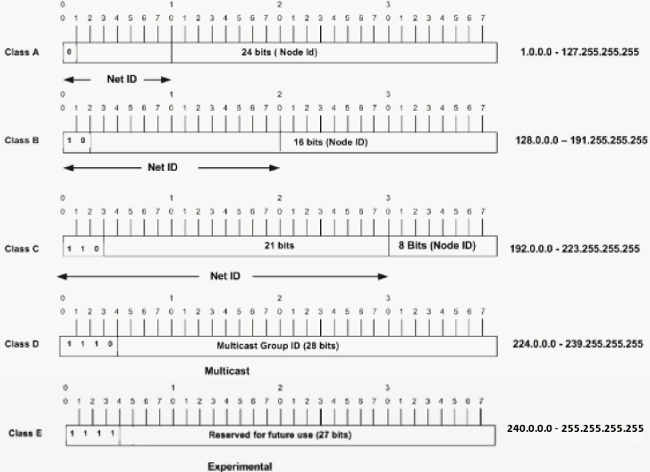
Em um endereço Classe A, o primeiro octeto é a porção de rede. Portanto, o exemplo de Classe A na Figura 1 tem um endereço de rede principal de 1.0.0.x - 127.255.255.x (onde x pode incluir de 0 a 255). Os octetos 2, 3 e 4 (os 24 bits seguintes) são para o gerente de rede dividir em sub-redes e hosts quando possível. Class A addresses are used for networks that have more than 65,536 hosts (actually, up to 16777214 hosts!).
Em um endereço Classe B, os dois primeiros octetos são a porção de rede. Portanto, o exemplo de Classe B na Figura 1 tem um endereço de rede principal de 128.0.0.x - 191.255.255.x. Octets 3 and 4 (16 bits) are for local subnets and hosts. Class B addresses are used for networks that have between 256 and 65534 hosts.
Em um endereço da Classe C, os primeiros três octetos são a porção da rede. O exemplo de Classe C na Figura 1 tem um endereço de rede principal de 192.0.0.x - 223.255.255.x. Octet 4 (8 bits) is for local subnets and hosts - perfect for networks with less than 254 hosts.
Network Masks
Uma máscara de rede ajuda você a saber qual porção do endereço identifica a rede e qual porção do endereço identifica o nó. Class A, B, and C networks have default masks, also known as natural masks, as shown here:
Class A: 255.0.0.0 Class B: 255.255.0.0 Class C: 255.255.255.0
An IP address on a Class A network that has not been subnetted would have an address/mask pair similar to: 10.20.15.1 255.0.0.0. Para ver como a máscara ajuda a identificar a rede e as partes do nó do endereço, converta o endereço e a máscara em números binários.
10.20.15.1 = 00001010.00010100.00001111.00000001 255.0.0.0 = 11111111.00000000.00000000.00000000
Depois que você tiver o endereço e a máscara representados em binário, a identificação da rede e da ID do host será mais fácil. Todos os bits de endereço com bits de máscara correspondentes definidos como 1 representam a ID de rede. Todos os bits de endereço com bits de máscara correspondentes definidos como 0 representam a ID de nó.
10.20.15.1 = 00001010.00010100.00001111.00000001
255.0.0.0 = 11111111.00000000.00000000.00000000
-----------------------------------
net id | host id
netid = 00001010 = 10
hostid = 00010100.00001111.00000001 = 20.15.1
Compreenda a sub-rede
Subnetting allows you to create multiple logical networks that exist within a single Class A, B, or C network. Se não criar uma sub-rede, você só poderá utilizar uma rede das classes A, B, ou C, o que é irreal.
Cada link de dados em uma rede deve ter uma ID de rede exclusiva e cada nó nesse link é um membro da mesma rede. If you break a major network (Class A, B, or C) into smaller subnetworks, it allows you to create a network of interconnecting subnetworks. Dessa forma, cada enlace de dados nessa rede teria uma ID de rede/sub-rede exclusiva. Qualquer dispositivo ou gateway que conecta n redes/sub-redes tem n endereços IP diferentes, um para cada rede/sub-rede que ele interconecta.
Para criar uma sub-rede em uma rede, estenda a máscara natural com alguns dos bits da parte da ID do host do endereço para criar uma ID de sub-rede. Por exemplo, dada uma rede Classe C de 192.168.5.0 que tem uma máscara natural de 255.255.255.0, você pode criar sub-redes desta maneira:
192.168.5.0 - 11000000.10101000.00000101.00000000
255.255.255.224 - 11111111.11111111.11111111.11100000
--------------------------|sub|----
Estendendo a máscara para ser 255.255.255.224, você pegou três bits (indicados por sub) da parte original do host do endereço e os usou para criar sub-redes. With these three bits, it is possible to create eight subnets. Com os outros cinco bits de ID do host, cada sub-rede pode ter até 32 endereços de host, dentre os quais, 30 podem realmente ser atribuídos a um dispositivo, pois as IDs de host all-zeros ou all-ones não são permitidas (é muito importante lembrar disso). Dessa forma, com isso em mente, essas sub-redes foram criadas.
192.168.5.0 255.255.255.224 host address range 1 to 30 192.168.5.32 255.255.255.224 host address range 33 to 62 192.168.5.64 255.255.255.224 host address range 65 to 94 192.168.5.96 255.255.255.224 host address range 97 to 126 192.168.5.128 255.255.255.224 host address range 129 to 158 192.168.5.160 255.255.255.224 host address range 161 to 190 192.168.5.192 255.255.255.224 host address range 193 to 222 192.168.5.224 255.255.255.224 host address range 225 to 254
Note: There are two ways to denote these masks. Primeiro, como você usa três bits a mais do que a máscara natural de classe C, você pode denotar esses endereços como uma máscara de sub-rede de 3 bits. Ou, a máscara do 255.255.255.224 também pode ser denotada como /27, uma vez que existem 27 bits definidos na máscara. This second method is used with CIDR. Com este método, uma dessas redes pode ser descrita com o prefixo/comprimento da notação. Por exemplo, 192.168.5.32/27 denota a rede 192.168.5.32 255.255.255.224. Quando apropriado, a anotação de prefixo/comprimento é usada para denotar a máscara em todo o restante deste documento.
O esquema de sub-redes de rede nesta seção permite oito sub-redes, e a rede pode será exibida como:
Figure 2
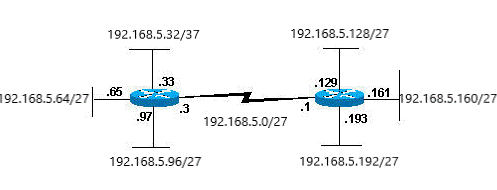
Observe que cada um dos roteadores na Figura 2 está conectado a quatro sub-redes, uma sub-rede é comum a ambos os roteadores. Also, each router has an IP address for each subnetwork to which it is attached. Each subnetwork could potentially support up to 30 host addresses.
Isso ativa um ponto interessante. Quanto mais bits de host você utiliza para uma máscara de sub-rede, mais sub-redes são disponibilizadas. No entanto, quanto mais sub-redes estiverem disponíveis, menos endereços de host disponíveis por sub-rede haverá. For example, a Class C network of 192.168.5.0 and a mask of 255.255.255.224 (/27) allows you to have eight subnets, each with 32 host addresses (30 of which could be assigned to devices). Se você usar uma máscara de 255.255.255.240 (/28), o detalhamento será:
192.168.5.0 - 11000000.10101000.00000101.00000000
255.255.255.240 - 11111111.11111111.11111111.11110000
--------------------------|sub |---
Since you now have four bits to make subnets with, you only have four bits left for host addresses. Portanto, nesse caso, pode haver até 16 sub-redes, cada uma das quais com até 16 endereços de host (14 dos quais podem ser atribuídos a dispositivos).
Veja como uma rede Classe B pode ser dividida em sub-redes. Se você tiver a rede 172.16.0.0, saberá que a máscara natural é 255.255.0.0 ou 172.16.0.0/16. Estender a máscara para além de 255.255.0.0 significa que você está criando sub-redes. É possível ver rapidamente que você pode criar muito mais sub-redes do que com a rede de Classe C. Se você usar uma máscara de 255.255.248.0 (/21), quantas sub-redes e hosts por sub-rede isso permitirá?
172.16.0.0 - 10101100.00010000.00000000.00000000
255.255.248.0 - 11111111.11111111.11111000.00000000
-----------------| sub |-----------
Você usa cinco bit dos bit originais do host para sub-redes. Isso permite que você tenha 32 sub-redes (25). Quando os cinco bits para sub-redes são usados, você fica com 11 bits para endereços de host. Isso permite que cada sub-rede tenha 2048 endereços de host (211), 2046 dos quais poderiam ser atribuídos a dispositivos.
Note: Antigamente, havia limitações quanto ao uso de uma sub-rede 0 (todos os bits de sub-rede são definidos como zero) e de uma sub-rede apenas com 1s (todos os bits de sub-rede definidos como 1). Alguns dispositivos não iriam permitir a utilização dessas sub-redes. Os dispositivos da Cisco Systems permitem o uso dessas sub-redes quando o ip subnet-zero comando é configurado.
Examples
Sample Exercise 1
Agora que você entende as sub-redes, coloque esse conhecimento em prática. Neste exemplo, você tem duas combinações de endereço/máscara, escritas com a notação prefixo/tamanho, que foram atribuídas a dois dispositivos. Sua tarefa é determinar se estes serviços estão na mesma sub-rede ou em sub-redes diferentes. Você pode usar o endereço e a máscara de cada dispositivo para determinar a que sub-rede cada endereço pertence.
DeviceA: 172.16.17.30/20 DeviceB: 172.16.28.15/20
Determine a sub-rede para o Dispositivo A:
172.16.17.30 - 10101100.00010000.00010001.00011110
255.255.240.0 - 11111111.11111111.11110000.00000000
-----------------| sub|------------
subnet = 10101100.00010000.00010000.00000000 = 172.16.16.0
Examine os bits do endereço que têm um bit de máscara correspondente definido como um e defina todos os outros bits do endereço como zero (isso é equivalente a quando você executa um AND lógico entre a máscara e o endereço). Ele mostra a você a qual sub-rede esse endereço pertence. Nesse caso, o dispositivo A pertence à sub-rede 172.16.16.0.
Determine a sub-rede para o Dispositivo B
172.16.28.15 - 10101100.00010000.00011100.00001111
255.255.240.0 - 11111111.11111111.11110000.00000000
-----------------| sub|------------
subnet = 10101100.00010000.00010000.00000000 = 172.16.16.0
A partir dessas determinações, o dispositivo A e o dispositivo B têm endereços que fazem parte da mesma sub-rede.
Sample Exercise 2
Dada a rede Classe C de 192.168.5.0/24, crie uma sub-rede para criar a rede na Figura 3 com os requisitos de host mostrados.
Figure 3
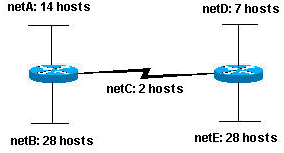
Ao observar a rede mostrada na Figura 3, você pode ver que é necessário criar cinco sub-redes. A maior sub-rede deve suportar 28 endereços de host. Isso é possível com uma rede da Classe C? And if so, then how?
Para começar, observe o requisito de sub-rede. Para criar as cinco sub-redes necessárias, você precisaria usar três bits dos bits de host Classe C. Dois bits permitiria somente quatro sub-redes (22).
Uma vez que você precisa de três bits de sub-rede que lhe deixam com cinco bits para a parte do host do endereço. A quantos hosts isso oferece suporte? 25 = 32 (30 utilizáveis). Isso satisfaz o requisito.
Portanto, você determinou que é possível criar essa rede com uma rede Classe C. Um exemplo de como você pode atribuir as sub-redes é o seguinte:
netA: 192.168.5.0/27 host address range 1 to 30 netB: 192.168.5.32/27 host address range 33 to 62 netC: 192.168.5.64/27 host address range 65 to 94 netD: 192.168.5.96/27 host address range 97 to 126 netE: 192.168.5.128/27 host address range 129 to 158
VLSM
Em todos os exemplos anteriores da criação de sub-redes, observe que a mesma máscara de sub-rede foi aplicada a todas as sub-redes. Isso significa que cada sub-rede tem o mesmo número de endereços host disponíveis. Isso é necessário em alguns casos, mas, na maioria dos casos, quando há a mesma máscara de sub-rede para todas as sub-redes, isso desperdiça espaço de endereços. Por exemplo, na seção Exercício de Exemplo 2, uma rede da Classe C foi dividida em oito sub-redes de mesmo tamanho; no entanto, cada sub-rede não utilizou todos os endereços de host disponíveis, o que resultou em desperdício de espaço de endereço. A Figura 4 ilustra esse espaço de endereço desperdiçado.
Figure 4
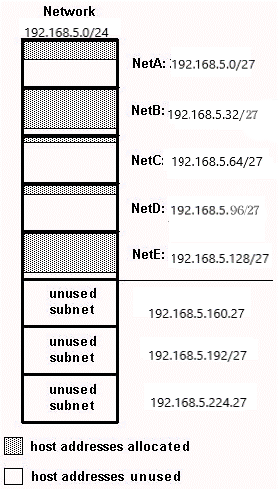
A Figura 4 ilustra qual das sub-redes é usada. NetA, NetC e NetD têm muito espaço de endereço de host não utilizado. É possível que esse tenha sido um design deliberado para o crescimento futuro; porém, em muitos casos, é apenas espaço de endereço desperdiçado devido ao fato de que a mesma máscara de sub-rede é usada para todas as sub-redes.
As VLSM (Variable Length Subnet Masks, máscaras de sub-rede de tamanho variável) permitem usar máscaras diferentes para cada sub-rede, assim, elas usam o espaço de endereços de forma eficiente.
VLSM Example
Dados a mesma rede e os requisitos do Exercício de Exemplo 2, desenvolva um esquema de criação de sub-redes com o uso do VLSM:
netA: must support 14 hosts netB: must support 28 hosts netC: must support 2 hosts netD: must support 7 hosts netE: must support 28 host
Determine que máscara permite o número obrigatório de hosts.
netA: requires a /28 (255.255.255.240) mask to support 14 hosts netB: requires a /27 (255.255.255.224) mask to support 28 hosts netC: requires a /30 (255.255.255.252) mask to support 2 hosts netD*: requires a /28 (255.255.255.240) mask to support 7 hosts netE: requires a /27 (255.255.255.224) mask to support 28 hosts * a /29 (255.255.255.248) would only allow 6 usable host addresses therefore netD requires a /28 mask.
A maneira a mais fácil de atribuir as sub-redes é atribuindo a maior primeiro. Por exemplo, você pode atribuir desta maneira:
netB: 192.168.5.0/27 host address range 1 to 30 netE: 192.168.5.32/27 host address range 33 to 62 netA: 192.168.5.64/28 host address range 65 to 78 netD: 192.168.5.80/28 host address range 81 to 94 netC: 192.168.5.96/30 host address range 97 to 98
Isso pode ser representado graficamente conforme mostra a Figura 5:
Figure 5
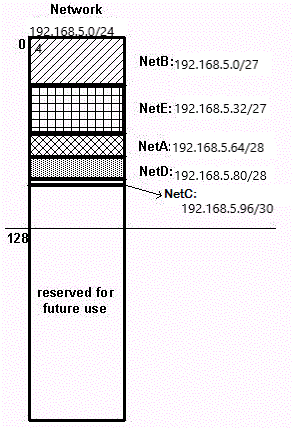
A Figura 5 ilustra como o VLSM ajudou a economizar mais da metade do espaço de endereço.
CIDR
O Classless Interdomain Routing (CIDR) foi introduzido para melhorar a utilização do espaço de endereços e a escalabilidade do roteamento na Internet. Ele foi necessário devido ao rápido crescimento da Internet e ao crescimento das tabelas de roteamento IP mantidas nos roteadores de Internet.
O CIDR se afasta das classes IP convencionais (Classe A, Classe B, Classe C e assim por diante). No CIDR, uma rede IP é representada por um prefixo, que é um endereço IP e alguma indicação do tamanho da máscara. O tamanho significa o número de bits de máscara contíguos à esquerda definidos como um. Portanto, a rede 172.16.0.0 255.255.0.0 pode ser representada como 172.16.0.0/16. O CIDR também representa uma arquitetura de Internet mais hierárquica, em que cada domínio obtém os endereços IP de um nível superior. Permite que o resumo dos domínios seja feito em nível mais alto. Por exemplo, se tiver a rede 172.16.0.0/16, o ISP poderá oferecer 172.16.1.0/24, 172.16.2.0/24 e assim por diante aos clientes. Ainda assim, ao anunciar para outros provedores, o ISP precisa apenas anunciar 172.16.0.0/16.
Para obter mais informações sobre CIDR, consulte o RFC 1518 e o RFC 1519 .
Sub-redes especiais
Sub-redes de 31 bits
Uma máscara de sub-rede de 30 bits permite quatro endereços IPv4: dois endereços de host, uma rede all-zeros e um endereço de transmissão all-ones. Um link ponto a ponto só pode ter dois endereços de host. Não há uma necessidade verdadeira de ter os endereços de transmissão e all-zeros com links ponto a ponto. Uma máscara de sub-rede de 31 bits permite exatamente dois endereços de host e elimina os endereços de transmissão e all-zeros. Portanto, mantém o mínimo uso de endereços IP para links ponto a ponto.
Consulte RFC 3021 – Uso dos prefixos de 31 bits em links IPv4 ponto a ponto.
A máscara é 255.255.255.254 ou /31.
A sub-rede /31 pode ser usada em links ponto a ponto reais, como interfaces seriais ou de PDV. No entanto, elas também podem ser usadas em tipos de interface de transmissão, como interfaces Ethernet. Se for esse o caso, verifique se há apenas dois endereços IPv4 necessários nesse segmento Ethernet.
Exemplo
192.168.1.0 e 192.168.1.1 estão na sub-rede 192.168.1.0/31.
R1(config)#interface gigabitEthernet 0/1
R1(config-if)#ip address 192.168.1.0 255.255.255.254
% Warning: use /31 mask on non point-to-point interface cautiously
O aviso é impresso porque gigabitEthernet é um segmento de transmissão.
Sub-redes de 32 bits
Uma máscara de sub-rede de 255.255.255.255 (uma sub-rede /32) descreve uma sub-rede com apenas um endereço de host IPv4. Essas sub-redes não podem ser usadas para atribuir endereços a links de rede porque elas sempre precisam de mais de um endereço por link. O uso de /32 é estritamente reservado para links que podem ter apenas um endereço. O exemplo dos roteadores Cisco é a interface de loopback. Essas são interfaces internas e não se conectam a outros dispositivos. Como tal, podem ter uma sub-rede /32.
Exemplo
interface Loopback0
ip address 192.168.2.1 255.255.255.255
Appendix
Configuração de exemplo
Routers A and B are connected via serial interface.
Router A
hostname routera ! ip routing ! int e 0 ip address 172.16.50.1 255.255.255.0 !(subnet 50) int e 1 ip address 172.16.55.1 255.255.255.0 !(subnet 55) int s 0 ip address 172.16.60.1 255.255.255.0 !(subnet 60) int s 0 ip address 172.16.65.1 255.255.255.0 (subnet 65) !S 0 connects to router B router rip network 172.16.0.0
Router B
hostname routerb ! ip routing ! int e 0 ip address 192.168.10.200 255.255.255.240 !(subnet 192) int e 1 ip address 192.168.10.66 255.255.255.240 !(subnet 64) int s 0 ip address 172.16.65.2 (same subnet as router A's s 0) !Int s 0 connects to router A router rip network 192.168.10.0 network 172.16.0.0
Host/Subnet Quantities Table
Class B Effective Effective # bits Mask Subnets Hosts ------- --------------- --------- --------- 1 255.255.128.0 2 32766 2 255.255.192.0 4 16382 3 255.255.224.0 8 8190 4 255.255.240.0 16 4094 5 255.255.248.0 32 2046 6 255.255.252.0 64 1022 7 255.255.254.0 128 510 8 255.255.255.0 256 254 9 255.255.255.128 512 126 10 255.255.255.192 1024 62 11 255.255.255.224 2048 30 12 255.255.255.240 4096 14 13 255.255.255.248 8192 6 14 255.255.255.252 16384 2 Class C Effective Effective # bits Mask Subnets Hosts ------- --------------- --------- --------- 1 255.255.255.128 2 126 2 255.255.255.192 4 62 3 255.255.255.224 8 30 4 255.255.255.240 16 14 5 255.255.255.248 32 6 6 255.255.255.252 64 2 *Subnet all zeroes and all ones included. These may not be supported on some legacy systems. *Host all zeroes and all ones excluded.
Informações Relacionadas
Histórico de revisões
| Revisão | Data de publicação | Comentários |
|---|---|---|
4.0 |
07-Jul-2023
|
Requisitos de estilo atualizados, descrição e formatação do artigo. |
3.0 |
13-Feb-2023
|
Seção Introdução e representação binária atualizadas em um exemplo. |
2.0 |
27-Jun-2022
|
PII removido e substituído por URL aceitável. Figuras atualizadas para remover o PII.
Formatação para idioma, fundamentos, etc. |
1.0 |
10-Dec-2001
|
Versão inicial |
Colaborado por engenheiros da Cisco
- Julio JimenezTAC Project Manager
Contate a Cisco
- Abrir um caso de suporte

- (É necessário um Contrato de Serviço da Cisco)
 Feedback
Feedback